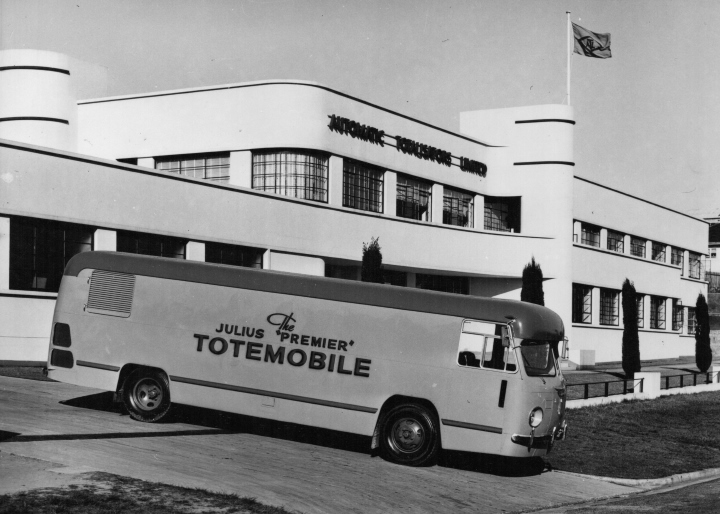
This is one of several pages relating to the history of the automatic totalisator, its invention in 1913, the inventor George Julius and the Australian company he founded in 1917, which became a monopoly, later part of an oligopoly in this field. This page is a continuation of the description of the factory at Meadowbank and the people who worked there. If you wish to start from the beginning then go to the index
Before completing Neville's memories of the factory, following is a summary of Automatic Totalisators Limited history during the early period of the Meadowbank factory, up until the introduction of the early computer totalisator systems. The design, development and manufacturing period after this was all about computer totalisator systems.
In late 1945, the company started in earnest to design totalizator equipment for post war use and, at this time, the J8 ticket issuing machine was born. The J8 proved to be a durable addition to the Automatic Totalisators terminal range. Up until October 1995, The Royal Turf Club of Thailand continued to use J8s as the on-course ticket issuing machine. Along with the ticket issuing machines, there was need for new designs in Mechanical Analogue Computers, Adders, Odds Relay Units and Indicators. The factory therefore, continued on at war time tempo for many years, in an attempt to fulfil the orders that kept rolling in. The company moved to the factory at Meadowbank in 1947.
The Meadowbank Factory with a Totemobile

The first batch of J8 Win, Place ticket issuing machines was installed on Randwick Race Course in 1948. The delivery of these ticket issuing machines to Randwick released a quantity of the existing J6 ticket issuing machines for despatch, along with some 2-shaft adding units, to the United States for use at Randall Park Racetrack. This was a stop gap move and in 1950 the company installed new equipment on this racetrack. That same year an associate company, Automatic Totalisators (U.S.A.) Ltd. was formed to purchase equipment from the parent company and lease it to racetrack operations in the U.S.A. This Company became a subsidiary and by 1967 the company had 23 operations in the United States and Canada.
In 1948 the first mobile tote was manufactured, and was used in the Sydney metropolitan and near country areas. In later years many more of these units were manufactured.
At this time the company entered the busiest period of manufacture and installation in its life. Simultaneously it was manufacturing and installing equipment for racetracks in India, South Africa, Australia, New Zealand, North and South America. In all, it installed equipment in 99 race tracks throughout the world between 1948 and 1955. The bulk of this equipment was for Win, Place pools only. At this stage, it catered for doubles and quinella pools with small fields only, but very soon after was confronted with the possibility of having to provide equipment for 24 starter fields.
The first real challenge came when all the Melbourne racetracks wanted combination pool equipment. In 1955 the company conceived the idea of using the principle of punched tape for recording investments on these pools and, in 1956 the company provided equipment in Melbourne using newly designed J10 24 starter ticket issuing machines, along with punched tape recorder and electronic readers. This equipment marked another milestone in the history of progress and within several years, this punched tape combination betting equipment was installed in South Africa, Malaysia, Singapore, and every capital city in Australia.
The company advanced into the sixties installing conventional equipment throughout the world, with the betting trend swinging more towards the combination betting pools than ever. Public indication of the state of betting in these pools had always been a problem. At Harold Park, the company installed a quinella indicator with 66 combinations, that is, quinella odds for 12 starters.
In 1964 the company took over Bell Punch New Zealand Ltd purchasing all their equipment in the field, taking over the operation of all their installations and this company was later known as New Zealand Totalisators Limited.
Automatic infield lamp box odds indicators were installed in 1965 on all the Melbourne metropolitan racecourses, including the new racecourse at Sandown Park. In some cases the barometer indicators were retained, and the company designed the equipment to allow these indicators to work in parallel with the lamp box indicators. Here the company had a link of the old with the new, namely the 1931 barometer indicators and the 1965 odds lamp boxes.
New control, access and aggregating equipment was also supplied to Melbourne and installed in an air conditioned van which moved from track to track. At the race track, the equipment was plugged into the racetrack facilities, plus an off-course console which allowed the off-course investments to be stored in the van so that, for odds and dividend calculations, the off-course investments could be added to the on-course investments.
In 1966 Automatic Totalisators Ltd took the racing industry into the electronic era with the development of the World's First Computer Totalizator System, for the New York Racing Association, which handled a totalizator turnover each season of over $700 million. This system had 550 type J11 Ticket Issuing Machines, two Infield Lamp Box type Indicators and twenty Auxiliary Odds Lamp Box Indicators. This installation was the culmination of many years of research and development. The equipment was portable and was moved from Aqueduct to Belmont Park and Saratoga, the northern tip of New York State, where a smaller operation was conducted making a total of 234 race day operations per year. Premier Equipment Pty Ltd, a subsidiary maintained and operated the equipment for all 234 race meetings.
Inspired by the success at Aqueduct, further research and development led to a more compact and economical Electronic Totalizator System using small General Purpose Computers with all the features of the Aqueduct system. This new electronic totalizator made its debut in November,1968 at a harness track in Georgetown, Delaware, U.S.A., and at Happy Valley racecourse, Hong Kong.
| Memories of the Factory part 2 |
The following is the second part of a transcription of an audio tape by Neville Mitchell and photographs he has supplied. Neville has held several management positions with the company Automatic Totalisators Limited. When I first joined the company, I think he was the manager of the drawing office.
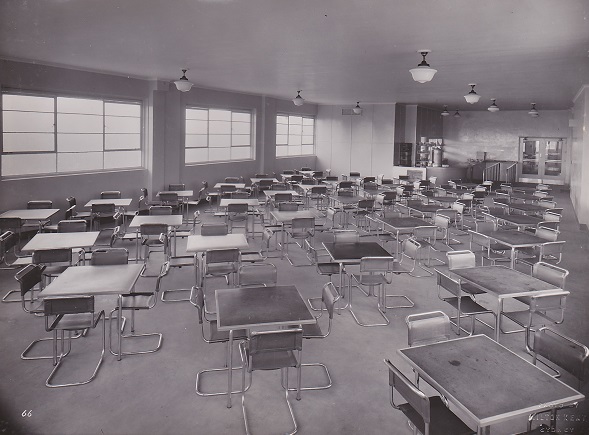
Here we have the picture of the canteen. In the corner there was the properly equipped kitchen that could provide 1000 meals a day. When you worked overtime you were provided with a three course meal. If you worked a night shift you were given breakfast as well. This was bacon and eggs and toast and tomato, the whole bit. You really felt like you were looked after in those days. The chairs were a bit of a problem. As they wore they became known as nut crushers because of that canvas, slim type seat, used to stretch and as you sat in it you sunk down between those steel tubes and often you would get down there and if you were a bit overweight you would get stuck.
One thing about this, when you went there you were sort of assigned a seat. If you went upstairs for morning tea and sat down with a group of guys, they would look at you as if to say "that seat belonged to someone else", you could not go and sit anywhere you liked. The hierarchy even extended to where you sat and ate lunch. The executive's lunch room was behind the kitchen and they ate separately to the production and office staff.
An animation of a J8 Ticket Issuing Machine
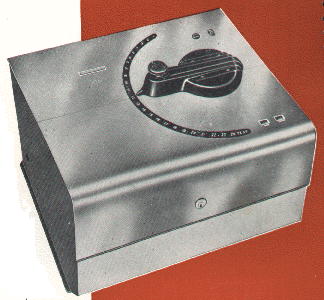
The wonderful J8 machine. I have no idea of how many they manufactured, but it was certainly in the tens of thousands. They were distributed world wide. This particular one is a multi value machine. You can see it had a value key that you could swap between 10 and 50 pounds.
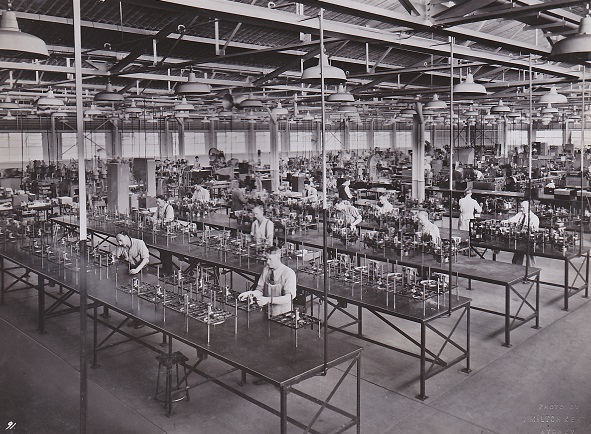 Part of the Assembly Section
Part of the Assembly Section
This is a view of the J8 assembly line, part of the assembly section. It shows the factory prior to an extension that was made. There was one more sawtooth that was added when Automatic Totalisators bought out Page Engineering and started to manufacture the yellow and black number plates for the NSW Department of Transport. This enterprise eventually shifted into its own factory across the street.
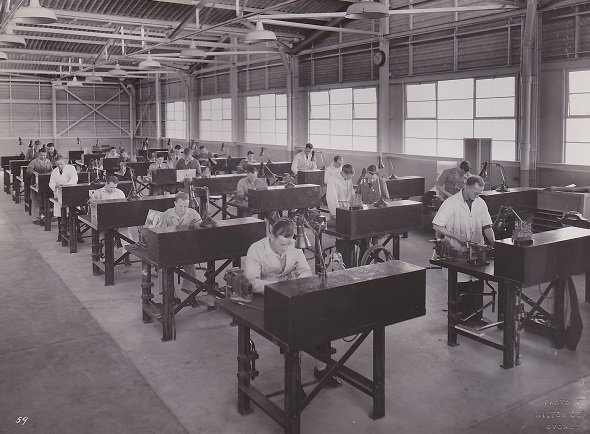
Here is the toolies hand fitting section, where the various dies jigs and fixtures were assembled and checked out. Notice that the work benches are solid cast iron they weighed close to half a ton each.
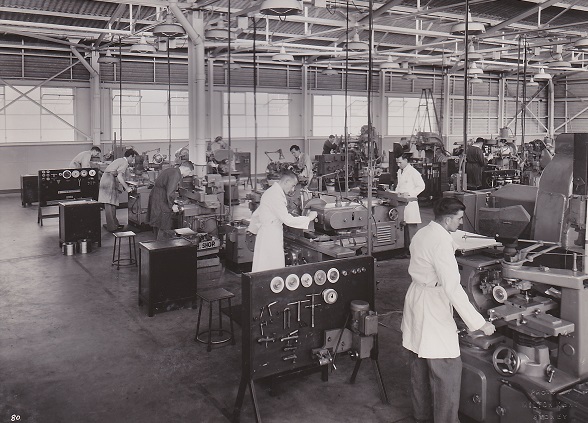 Precision Grinding Department
Precision Grinding Department
Part of the machine room for the toolies. All precision machinery surface grinders and centreless grinding jig boring and overhead mills.
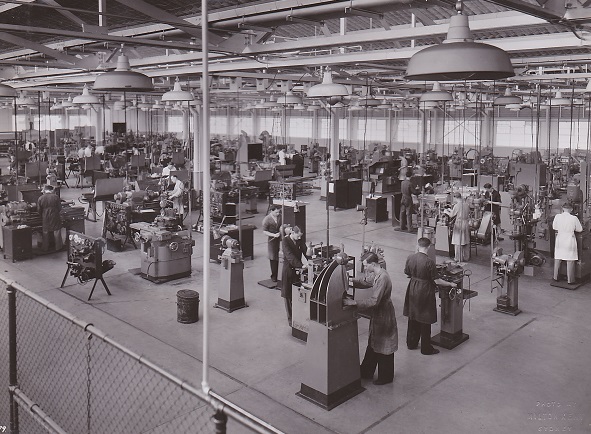
The production floor shop, these are some of the machines used in tool maintenance. As you can see the amount of machines was enormous.
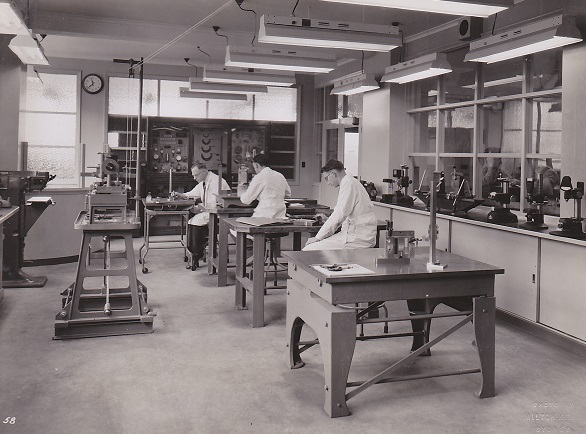 A section of the Metrology Laboratory
A section of the Metrology Laboratory
This is the metrology department. This room was air conditioned and the laboratory was certificated to National Laboratory standards and they did a lot of checking and testing work here. I particularly remember the stage when we were subcontracting the manufacture of parts for the Victa Air Tourer aircraft and every part was taken through here and tested for accuracy and was X-rayed and hardness checked, all that sort of thing which went into certifying a part suitable for an aircraft.
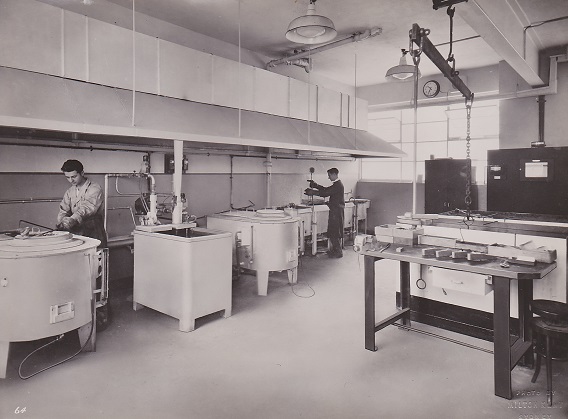
The heat treatment area. It was run by a bloke named Bob, he was a Communist. Of course the whole factory was unionised, very very strictly unionised. He was one of those soap box blokes so whenever there was a union meeting this bloke would be up the front and wanted to get on his soap box. The area where this heat treatment room is was in the annex under the men's locker room. If you look at the sewerage pipes up there you can see the additional pipe they put in there which drained that rare washing basin I talked about before. The heat treatment room was eventually moved to the new toolroom across the street. The image shows a group of Liquid Heat Furnaces. Of particular interest is the Isothermal Furnace.
Webmaster's note: I recall this room very well. It was next door to the Installation Department. When I started with the company I was assigned to the Installation Department under Ron Hood who was the manager. I spent a lot of time at a desk on the other side of the left hand wall in the above photo, studying PDP 11 architecture and hardware, as well as ATL products. I was very fortunate to have Ron as my manager. So long as I was reading ATL or DEC manuals and studying engineering drawings from either company, Ron was happy. I was ecstatic with this uninterrupted opportunity to learn. I was ecstatic and Ron the manager was happy an ideal rarely achieved! I joined the company with the intention of moving to Queensland with the new computer tote systems. It is funny how sometimes a casual remark can end up enormously prophetic. Ron told me, as a fledgling in the company, that I was in a fortunate position as I would have a job that I could mould into whatever I wished. I paid little attention to this comment at the time, primarily because I could not see how something like that could happen. I have recently retired and in retrospect Ron was absolutely correct. Having introduced Ron, let's take this opportunity to introduce some human interest into this textbook-like review of the factory.
Neville Mitchell wrote in June 2014:
Iraq had a PDP11 tote, it was installed about the time of the six day war? It had J11 TIM's and a large infield indicator. The installation engineer was Sir Rex Turner the project manager was Ron Hood.Three Iraqi engineers ex army came to ATL for training. Ron befriended them and they became excellent customers buying many Australian racing products through ATL. One peculiar shipment was Swimming pool filter sand! Otherwise it was racing saddles crops, and horse related gear.
Rex got caught up in the war. He was confined to his hotel. A Russian oil prospecting team were also at his hotel. They invited Rex to flee Baghdad with them. This included a 600 Km truck ride into the desert from where they were taken by aircraft to Sophia in Bulgaria. He had no visa, so he was confined by the KGB until consulate , QANTAS & ATA rescued him, flying him out via London. Rex never went overseas again! Webmaster's note: Rex has written this story below under the heading Baghdad - Al Furusya Club - Al Mansur
The image below shows Ron Hood with two of the Iraqi Engineers. This photo was taken in the installation Department where I worked/studied, next door to the heat treatment room, approximately a decade after the 6 day war. There are some PDP11 racks visible behind Ron. It was the architecture of the machines in these racks that I was studying. In the foreground of this photo, in front of Ron and the Iraqi engineers, is a J18 ATL TIM (Ticket Issuing machine.) It was machines like this that I was also studying. The TIM has its covers removed because this department was engaged in engineering work on them. Ron has a rather rare, in my time, circuit board he is pointing to and presumably is discussing with the engineers. This photo is possibly posed for, however it is indicative of the training that took place. The circuit board under discussion, is part of a PDP11 and is called a single height circuit board. By far, most of the DEC PDP11 boards in my time were hex height boards, which were over six times the width of the board being discussed. In the background of the photo, near the PDP11 racks, between Ron on the left and the engineer next to him, extending out towards Ron from behind the upper arm of the engineer in the blue shirt, there is another DEC PDP11 circuit board. As can be seen, this is similar to, but a lot wider than, the board being discussed. As this board in the background is partly obscured, I can only conclude that it will either be a quad height or hex height board. This board is probably sitting on top of an expansion box pulled out on its runners from the right hand rack. These expansion boxes each housed over 20 Hex Height PCBs (Printed Circuit Boards.) Each Hex Height slot in the backplane could alternatively house 6 single height PCBs instead. This height classification of DEC PCBs refers to the number of backplane connectors on the board. Each rack would house 3 or 4 expansion boxes.
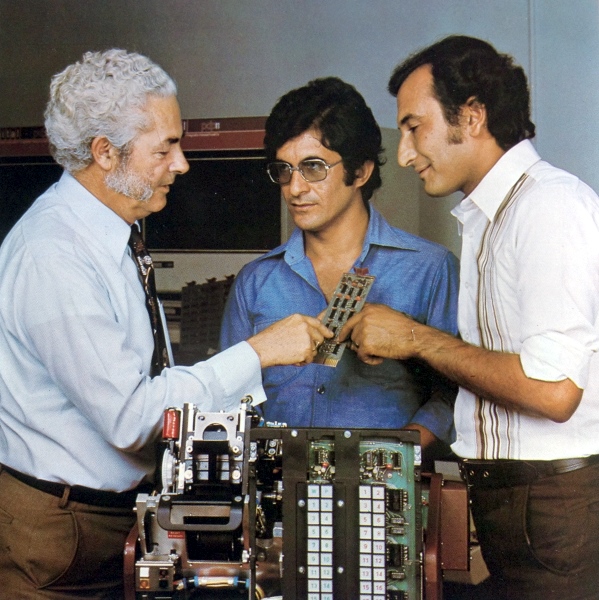
Above is an image of Ron Hood with two Iraqi engineers being trained on the ATL computer totalisator that they will maintain in Baghdad when the system goes live. This photo was taken in the Installation Department's premises next door to the Heat Treatment Room shown in the image above the one of Ron.
Rex Turner wrote the following about the two engineers with Ron Hood in the image above: I do not recall ever seeing the two gentlemen shown in the photo with Ron Hood. The only two other engineers I worked with were Ra'ad and Adnan. I only have a snap of Adnan. Ra'ad was also an entrepreneur owning a company that won tenders for the construction of important large scale road projects in Iraq.
Rex also wrote the following anecdote:
There was an amusing incident which occurred, Ron Hood was holding the lid of a J10 Ticket Machine up when he accidentally let it go. It slammed down and trapped my thumb between the bottom and top of the case. Amid the blood, convinced it was fractured we sped to hospital.Neville also wrote a comment about the above image: That's a great photo of Ron and the Iraqis. The J18 looks good too!This was the first time I have visited a hospital; been taken straight to the Operating Theatre no questions asked, no nurse present and located the surgeon, actually asleep on the operating table. It was a lucky day, my thumb was not broken. No Triage, compare that with today's modern hospital.
 Go back to the index
Go back to the index
 Go to the bottom of the page
Go to the bottom of the page
Neville Mitchell wrote in May 2015 regarding Ron Hood. Extracts follow from this and a previous email dated 11 June 2014:
I was searching through my old photo file and I came across a photo of our great friends Ron Hood and George Jenkins. ... Talking about Ron Hood, we both worked for a radio and television company, Stromberg Carlson, In Bourke street Alexandria. Ron came to work at Stromberg Carlson in 1960. We were mates from day one. Ron was my best friend over more than 40 years. Ron was a model maker in the research division of SC, I was a trainee cadet engineer in the same office. We worked together on many prototype radio, television and electronic organ developments and on the introduction of TV manufacture. Ron made up the mechanical parts of the production test equipment to George Jenkins and my designs. When the SC electronic organ went into production, Ron was assigned the management of the department, he was saddled with young women immigrants as workers, lots of fun getting them to understand English.The 1962 recession made Ron redundant, luckily he was picked up by ATL's then general manager Harry Ibbotson, who was an ex-SC manager. I was given the Organ department to run until I too was retrenched and joined Ron at ATL in May 1962. Luckily ATL took on quite a few ex SC engineers including Ron, George Jenkins, Morrie Cox, Bert Rowe and me. At that time I rode a Lambretta Motor scooter. Each afternoon I would give Ron a lift to Redfern station on the pillion seat of the scooter. We became family friends working through the usual problems with children wives and of course ATL!
Ron and I had a lot in common, our families were similar, two girls and one boy, our friendship extended across lots of activities. We both could play the organ, Ron was not too bad, his father in law was an expert piano tuner/restorer, music was a everyday part of their household. Molly passed away in January 2011, Ron & Molly had moved into a retirement village in Port Macquarie shortly before Ron passed. Molly deteriorated quickly after Ron's passing. Webmaster's comment, Ron and Molly visited us in Brisbane in the late 1990s long after our time together at ATL. I had no idea it would be the last time I see them!.
Neville wrote the following in February 2016 about two Lebanese engineers visiting Automatic Totalisators Limited for product support training:
The two engineers were Cousins Sammy & Nabil, I was good friends with them, they spent a lot of time with my family. They were just a little older than our Michele & Elizabeth, so lots of loud music and dancing at parties. When hostilities broke out in Lebanon they fled with their families to Paris. Never heard of them since.They were working for the Hippodrome du parc de Beyrouth Racing Club. They never got to operate the doomed Beirut Tote as wars raged around the city for years, finally a battle on the race track put an end to the saga.
Beirut race course was not totally destroyed when a skirmish took place. The Israeli army arrived in tanks and used 50 mm cannon shells causing severe damage to the structures. I saw a photo of one of the Computer units, I think it was a scanner, with a large hole from a shell passing through it. I have never heard of the Baghdad race track being destroyed, there was a very ornate grandstand and associated buildings including a separate ladies club room, they were not admitted to see the races.
Neville Mitchell wrote in July 2015 in response to my mentioning that I had recently visited Colin and Dale, two excellent ex ATL programmers. They both had realised long held dreams of owning farms. The following extracts contain two references to Ron Hood:
Must have been good to catch up with Colin and Dale. Strange how two excellent software guys turn into farmers! Bill Johnston had a cattle farm for many years after he left ATL, Assistant General Manager David McFarlan had a farmlet near Canberra.Colin and I worked together for quite a long time, never anything that we could not solve with just talking it through. I suppose Colin did not tell you the story of him being in Manilla with his long fuzzy blond hair? I recall Ron Hood telling us about their time in Manilla. They, the installation engineers, were walking on the streets of Manila, Colin at that time had lots of long blonde hair combed out so it was a full head. Apparently with the sun shining through Colin's hair, it appeared as if he had a halo. Much to the delight of the local, very Catholic populace, who immediately thought he was Jesus Christ, then making a big fuss of him.
And there was the night in Melbourne with Dale and Pat at a Richmond Motel. We had worked the gallops at Sandown Park and the Trots in the evening, got back to the motel about midnight. Ron Hood had asked the manager to put a carton of beer in his room fridge. Ron was irate when there was no beer, so he knocked up the manager in his pyjamas and dressing gown, who reluctantly brought the beer to Dale & Pats room, where we all settled into a long session of ATL talk mixed with a few beers.
I remember flying back to Sydney next morning with Ron feeling a bit hung over. Hardly got back to Meadowbank, when we were packed off to Brisbane to do some strike breaking at a Brisbane track. Still overworked and stressed we were then flown back to Sydney to operate Harold Park Trots and the Randwick Gallops. Ron was very cranky as we were seated in the last two rear seats in a DC 9, with a very noisy jet engine churning away outside Ron's window. He complained to the Stewardess and we were moved to the front of the aircraft.
Neville sent the following in January 2016, after I related a similar experience on a DC9, where I had the same seat as Neville describes, on an ATL business trip returning from Melbourne to Brisbane. I mentioned the beat frequency, resulting from the two poorly synchronised engines, to a friend of mine, who was a First Officer on DC9s at the time. He indicated that this was a problem, as it is hard to adjust the engine synchronisation due to the difficulty of hearing the beat frequency, from the flight deck at the opposite end of the aircraft.
We, that's Nancy daughter Elizabeth and I were to fly from Guam to Brisbane on a Continental Airlines DC10. We had sat on the plane from midnight to sunrise because the little green light on the wing would not come on. Captain, a Mr Foster, informed the passengers that he could not take off until the light was fixed, or we could fly when the sun came up, about 6 am, which is what happened. Anyway the DC10 had seen better days, the hunting of the three unsynchronised engines caused distinct shudder to regularly pass through the planes cabin. Arrived into Brisbane 7 hours late for our connecting flight home. I found this remarkable. A DC10 delayed 7 hours due to inability to get the starboard navigation light repaired, even though it is no doubt outside normal maintenance business hours! Additionally, I presume some protocol demanded that the passengers remain on board all this time.
Also in January 2016, Neville recollects more about this part of the factory: Also on that side of the building was the Print & Type shops, Maintenance Workshop the Emergency Power Generators the Welding Bay and finally the Spray Painting Booth and baking oven. The first aid room was under the stairs up to the canteen and at the south front was a area used for crate making and packing goods for delivery.
I used the staircase to the canteen mentioned by Neville, up to three times a day for morning tea, lunch and afternoon tea. I also remember the first aid room and the packing section.
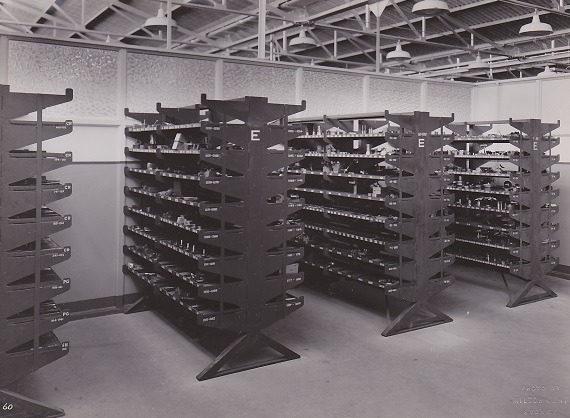 The small tool storage racks
The small tool storage racks
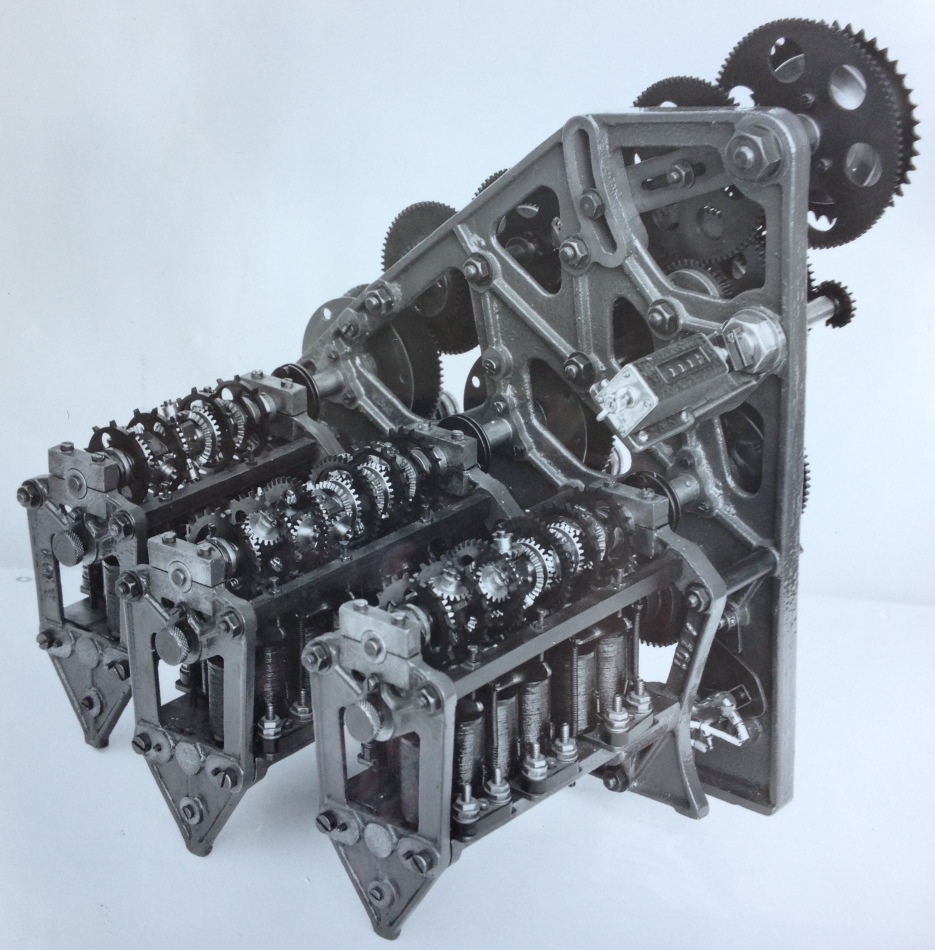
A nice view of an adder. Everything on it is manufactured by Automatic Totalisators except the rotary counter and the mercury switch located at the bottom right. This is a three shaft adder, a work of art. It had the capacity of up to 240 ticket issuing machines.
The Meadowbank Factory

The land to which Neville refers below, is the land that the factory is standing on. It includes the land on the near side of Nancarrow Avenue on which the photographer is standing. This land across the road from the factory, is where ATL built a separate tool-room which became necessary due to growth of the business.
Earlier in the tape I was talking about Julius acquiring the land at Meadowbank. The story behind why he wanted to build, in those days, way out in the boondocks comes from the war time and post war era, from the factory that was located in Crown Street in the city. The problem with the factory there was the proximity of all the hotels. There was a hotel or pub on every corner. They had great trouble keeping the people at work especially working three shifts as they did all through the war years. So when he looked for a site for the new factory, one of the prime considerations was that it had to be at least a mile from the nearest hotel. He achieved that with a vengeance, because the closest hotel was way down at West Ryde and it certainly wasn't a place that you could get to, have a drink and get back to work in your half hour lunch break. However over the years of course we have spent many pleasant hours there after work especially after Friday night with the likes of George Klemmer and Peter Rolls etcetera. The problem with alcohol at the Crown Street Factory had many hilarious tales of how the people who worked there brought the illegal liquor into the place so that they could imbibe sometime during the night. There was many stories of people being found asleep and that sort of thing and getting suspended, you could not sack them in those days so they would be suspended without pay. So when he decided on the new factory it had to be well away from anything like that.
This is an interesting point for me. When I joined Automatic Totalisators in 1977, I was surprised to find that we would often attend the Wallumetta Club for lunch on Fridays. This was a Businessman's Club on Victoria Road that was not far away. In all previous jobs, work and partaking in alcoholic beverages was kept quite separate. In this instance, it was accepted. With the passage of time I began to realise that this was bigger than I had first imagined. I started to recognise more of the people at the club and I came to realise that the patrons at the club on Friday afternoons was a who's who of Automatic Totalisators. Occasionally the stay at the club extended beyond lunch hours and little work was done at the factory for the rest of the afternoon. Several of the management staff thought that this was actually a productive exercise as more communication took place at the Club than at the factory. I tend to concur, as the major topic of conversation was always Automatic Totalisators and people from different departments would often be engaged in conversation.
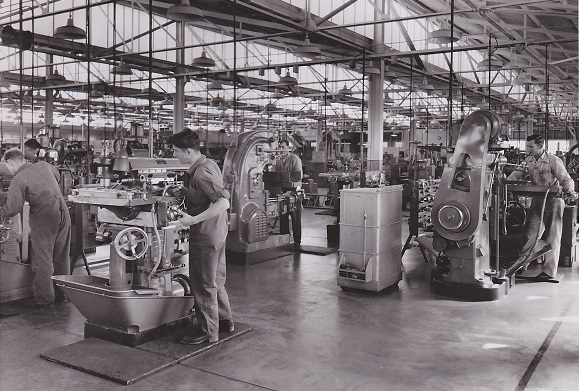
I have included one more photograph from Neville's collection which he has not commented on. This photograph above has particular significance for me. In my latter school-days, I spent a holiday break working at William Adams, another engineering company, for work experience, as arranged by my father. I learnt a lot about the workings of a machine shop and most of my time was spent operating a milling machine which has fired my interest in the ATL Precision Milling Department as shown in this photograph.
Before moving on, Neville mentioned Rex Turner getting caught up in a war, whilst working on the Baghdad Project, above the image of Ron Hood and the Iraqi Engineers above. Rex has written his recollection of this project in the following section. I find this very interesting from a technical standpoint as I have seen earthing problems in electronics equipment flummox some otherwise competent technical people. Additionally it demonstrates the general problems that can be encountered working on overseas installations. When considering overseas installations I often think how different it must have been installing Julius totes all around the planet starting in the early 1900s without a global aviation industry or global telephone network. The logistics must have been a lot more complicated relying on snail mail communication and ship rail and road transport. Before presenting Rex's anecdote, I will present some of the additional interesting information that Rex wrote to me which follows:
As you are aware I was a Radar Engineer, for a couple of years stationed in Gibraltar. While there I was having a great time servicing a new transistorised Radar on top of the Rock, teaching Radar Fundamentals and transistor design. It seems this was not enough, a Wing Commander ordered I go to a yacht moored in the Marina and fix it. Apparently the Naval Dockyard had been attempting to fix it without success.The yacht belonged to an ex-reporter who was present at the Nuremberg trials of World War 2. A chap with a thunderous voice and travelling with his child prodigy. A baby grand was the centrepiece of the yacht but that day it had various people on board. One of them being the chap who wrote the James Bond stories. None of this meant anything to me at the time, I was there simply to fix a radar. Nothing could distract me and my love of fixing a defective radar. Luck must have gone my way as I located and removed the faulty part intending to fix it elsewhere. I reckon that writer chap would have turned Neville's account into a best seller.
Needless to relate, after this remarkable luck I was commanded to fix a Coastal Command Rescue boat, submarine, Salvage boat and there it ended, I was posted to Anglesey the most depressing place imaginable.
| Baghdad - Al Furusya Club - Al Mansur |
Just back from working at the Philippines Racing Club and a few days late. I was diverted to problems at the Manila Jockey Club; with 48 hours to opening day the CCTV reticulation system was flawed. Recently migrating from England and having been involved in computer systems earthing to machine Tools; aware how few machines were functional during the 1970 Paris Machine Tool Exhibition. Computers are sensitive to static electrical effect; knowledge of a demonstration at Leeds University conducted years ago by a former colleague caused havoc with their Computer system. Simply rubbing his shoe across the carpeted floor and touching his hand on any metallic part of the computer was sufficient to cause system failure.
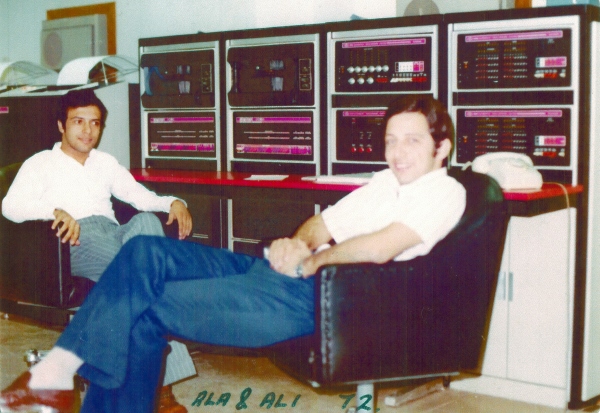
The realisation that toilet facilities were just a tad short of best practice at Al Mansur was disturbing. Above the hole in the ground surrounded by excreta dangled a rusty chain; joined together at several points with various pieces of string. This was large fly territory, swarms of them. The racing club must have realised that toilet arrangements were unsatisfactory and rapidly had a toilet facility installed outside the Totalisator Room. The whole installation went without significant hitches. Although I failed to realise the small computer test unit was unable to function, it had no connection to electrical ground.
Electrical Static was so bad, this installation would never function without a virtual earth. Getting the hole dug to install a similar earthing system to the Philippines Racing Club was a formality. Digging started without preamble and off we went to an extended lunch. The hole they dug was magnificent, very very deep, as the men laboured in its depths. I felt guilty, failing to give them a depth measurement. Experienced in surveying I had noticed that from the Baghdad Hotel adjacent to the Euphrates and on to the racecourse there were no significant changes in land level, luckily the Euphrates River was starting to swish around in the depths of the hole.
Sales people wore static wrist bands connected to the earthing system but never caused an unexpected system breakdown. Failure to keep the band tight resulted in multiple burns around the wrist. The easiest solution was to keep one hand touching a metallic part of the selling machine. The deterioration in my health over the 3 months project was evident to everyone. Only at the end of the project was I told to eat the live yoghurt every day to combat the problem.
The Baghdad hotel seemed to be in a state of unrest, a 24 hour curfew had been imposed. Tank tracks were visible as we were chauffeured to Al Mansur next day. We heard a political party had been exterminated; the emerging Saddam Hussain's Ba'ath party was flexing its muscles. However life seemed to continue without further interruption. I never witnessed the Israeli fighter which was apparently shot down above Baghdad. As a result our rooms were changed to be closer to the ground; most of the lighting was switched off and candles used in the passageways. Another race meeting, the third, was completed without incident and my time was over on this project.
Checking out of Iraq consists of visiting various Government departments around the city, Ali and Ala made it possible. When the paper I was carrying eventually filled with signatures I booked a flight out. It was made clear I had to leave the country next day without fail.
A gentleman eventually came to inform me all flights leaving Baghdad were cancelled. I could either, travel by road and hope to be allowed into Kuwait, or accept an air ticket to fly from Basrah to Istanbul. I had no idea of the rules applicable to any traveller flying by Charter Aircraft. Joining the plane is no problem but leaving the flight can only be at the final destination. A fine of US $10,000 per passenger was in force at that time. Getting to Basrah was to be no problem if I joined a truck leaving right away. A group of archaeologists had spent considerable time on a dig out in the desert, were pleasantly on their way back home to Zermatt in Switzerland. Chatting with a gentleman at Basrah airport made the time pass quickly until he announced he had to go. Eventually my departure was called; I joined the queue. Passengers were being searched. Reaching the front of the queue I was confronted by a customs officer, the same gentleman with whom I had been chatting. I was not searched.
My attempts to get off the plane at Istanbul were thwarted by someone in authority. At the next stop in Turkey a similar thing happened. Warsaw proved to be different, I was escorted to the underground 'hotel'. At the same time I took the opportunity to book a flight to Lebanon. Travelling in a light shirt and no coat was causing me to feel cold, outside it was snowing. I requested my luggage and was led away to a room. The officer present had my suitcase but after a barrage of questions would not permit me to open it. Next morning I realised something had happened; the plane for Lebanon was cancelled, there was fighting in Beirut, civil war had broken out. Back to book yet another flight, this time to Athens to Sydney via Sofia in Bulgaria. Landing in Sofia another setback, my plane had missed the connection to Athens by a couple of hours. To my surprise I was allowed to enter Sofia and given free Hotel accommodation for a week. Finding my way around Sofia I located the telegraph office and sent a message to ATL requesting a ticket Athens to Sydney. Somehow the ticket went to Sofia in Greece. Arriving home the Queensland Totalisator project occupied my time but a new set of faces back at the ATL works were taking over, I realised it was time to move on, clearly I was excess to their requirement.
Webmaster's note: It was on the Brisbane Project Rex mentions, that I met Rex. He completed the Brisbane installation and not long after he left to take up a position with Raytheon. I thoroughly enjoyed working with Rex. Members of the on-site Brisbane project team spent a week end in Rockhampton and Keppel Island when I flew them up from Brisbane in a Piper Aztec F. Rex came on this flight and a few days ago in February 2016 he told me on the phone that he enjoyed that memorable week end. I missed Rex when he left the company. There were few in the company that I had regular contact with, who enjoyed discussing such subjects as application of Thevenin and Norton Equivalent Circuits.
The two Iraqi engineers Ali and Ala attended the same conversion course at DEC as myself in 1973, though in their case it was conversion and assimilation and in my case it was a major case of attempting to learn electronics and computers. On that course and a subsequent time in the factory there were two Iraqis, two Filipinos, one from Singapore and two Kiwis. A real League of Nations!
| Factory memories from Rod Richards |
It is February 2016 and I have just added Rex Turner's recollections of the Baghdad project above. It ended up there as a result of having a closer look at the Installation department in this factory. Neville Mitchell, who has been the source of most of the information about this factory history, mentioned that Rex, who was one of the installation engineers, had an interesting story about the Baghdad installation. I have just noticed that Rex Turner's article is now immediately above Rod Richard's which in no way was part of my intent.
It so happens that Rod Richards and Rex Turner met long after both their periods with ATL. They ended up playing bowls with each other every week. They independently discovered that they both had worked for ATL, Rod having well pre-dated Rex's era with the company. I have just mentioned above that Rod performed the Julius tote installation at the Ipswich Amateur Turf Club in Queensland. What they did not realise until I informed them was that Rex had replaced the Julius Tote, that Rod had installed in 1950, with a PDP11 based computer totalisator which started operations 29 years later! Additionally, that PDP11 based totalisator at Ipswich and at other tracks in Queensland was my first project with the company and I looked after those systems as well as successor systems.
It was only when Neville and Nancy Mitchell, Narelle and I, met with, Rod and Elizabeth Richards at a coffee shop in Parramatta in 2015, that Neville and I discovered that Rod not only knew Rex but met with him regularly. Neville and I along with others in the ATL fraternity had lost contact with Rex. Without Rod's information that reconnected us with Rex there would have been no Baghdad project article to be included above.
Following are Rod's recollections relating to the ATL factory at Meadowbank:
I started at ATL in early January 1949 as a 17 year old second year apprentice as I had to transfer from a small Press Metal shop that had to close its doors and I was left without a job. This however was a blessing in disguise as not long after I started my first year, the company moved to a larger shop at Matraville from Clovelly and at about the same time my family moved from Annandale to Ermington near West Ryde. This left me with a massive amount of travel each day to get to work and to go to Tech at Ultimo a couple of nights a week; my 30 shillings a week wage went mostly on fares; I soon became disenchanted with the whole affair
I could not believe my luck when I was accepted at ATL, to continue my apprenticeship, this massive modern almost new factory, certainly beat the hell out of the old Fibro shed that I had just left, also ATL was just a bike ride from home and a new Tech College had just started at Meadowbank, fate and my fairy godfather was certainly looking after me.
On my first day at ATL I was introduced to man in charge of the Adders, Fred James an old Tote man whose first words were "Rod, I do not care how long it takes, but it must be done right" I still remember those words as I still tend not to take short cuts. Although "take your time" was not quite right as Totes was at the time super busy with a number of jobs in the pipe line and overtime being worked. I recall that towards the end of the year 1949, the Randall Park job in the USA was top priority as it had to be completed before a certain date to meet the racing carnival or severe penalties would apply, I think we even worked Boxing Day and air freight was involved.
I worked mainly with the Adders and not to ramble on for too long a couple of things stick in my mind; One is the Number Counter mounted on the Adder, this was commonly known as "The Veeder" as the Counter was made by Veeder - Root and the name Veeder just seemed to stick.
The Escapement Shaft was also an assembly that required some careful assembly as the brass bevel gears had to be de burred so that they ran smoothly when assembled, this was done with the aid of a fine knife file. The Escapement Wheels were also assembled to the Cross Head with four BA Csk Hd screws with a similar product to Loctite. Once the assembly was completed the unit was then "Run In" mounted in a fixture in an enclosed tank and run with a light oil as a lubricant. Each Escapement Wheel was locked off in turn to ensure that all the bevel gears were being run in. The end result was that the whole assembly was like a piece of silk to turn. Alf Burnell was the man that took a personal interest in each Escapement Shaft that left his care.
Those were the days!!
Rod also provided the following interesting comments on static triggered by Rex's article above. The following relates to another factory where Rod worked after leaving Automatic Totalisators Limited:
On leaving ATL in 1962, I started with 3M Company at St Marys as a part of the staff involved with the manufacture of coated abrasives. As then, a new first of type highly confidential machine from the USA was installed at the factory. Safety was a major concern with the manufacturing process as there were various highly inflammable solvents used in the adhesive systems and static electricity was one of the problems. To avoid static generated by clothing, everyone who entered the factory had to wear static chains, which was a simple but effective device made from a large paper clip with a small brass chain attached. The paper clip was opened to attached to the side of the shoe and to come in contact with the wearers sox, the brass chain then came in contact with the concrete floor as the person moved around effectively earthing him.
Rod's Static Chain being discussed
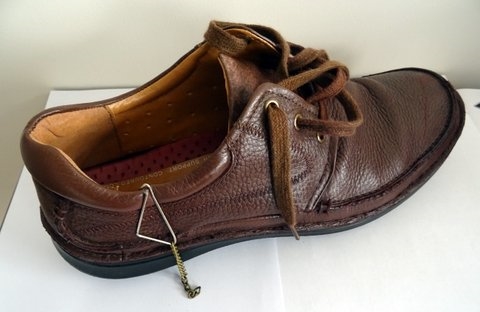
I did sometimes wonder how much of a problem was static, for as part of the manufacturing process the abrasive mineral particles were 'electrostatically' picked up and adhered to the adhesive coating on the backing; similar to a magnet picking up iron filings.
A little on 3M and coated abrasives. Prior to 1962 3M imported nearly all coated abrasive used in Australia, both in large rolls to be converted into finished goods such as sheets, endless belts etc and specialised finished goods that were manufactured in 3M St Paul Minnesota USA. Australia at that time had a growing car industry and many other growth industries that used various forms of coated abrasives products. At that time our industrial growth in Australia was going very well, so much so that 3M decided to manufacture coated abrasives in Australia. As a major investment, 3M installed at St Marys, the state of the art abrasive maker, known as the TAM (tunnel abrasive maker) which was developed in St Paul. Our TAM was the first machine built and was able to produce high grade products to the growing industrial markets. The TAM was operating 3 shifts a day 5 days a week to keep up with the demand for coated abrasives and provided many jobs for people living in the area. I was employed as the first QC inspector to work in the TAM and I could tell lots of stories about getting it up and running --- reminded me of tote installations in a way!
| Acknowledgements |
Comments and suggestions welcome to
totehis@hotmail.com
| Previous page | Go to the index | Top of the page | Next page |